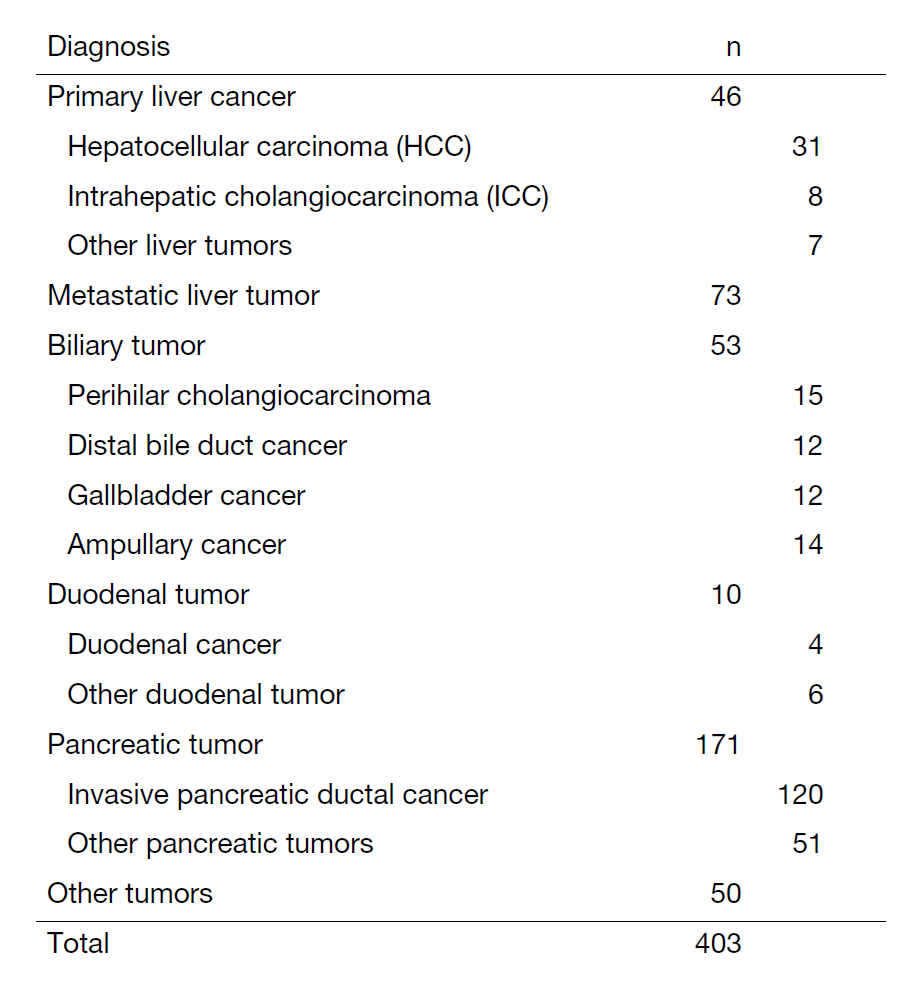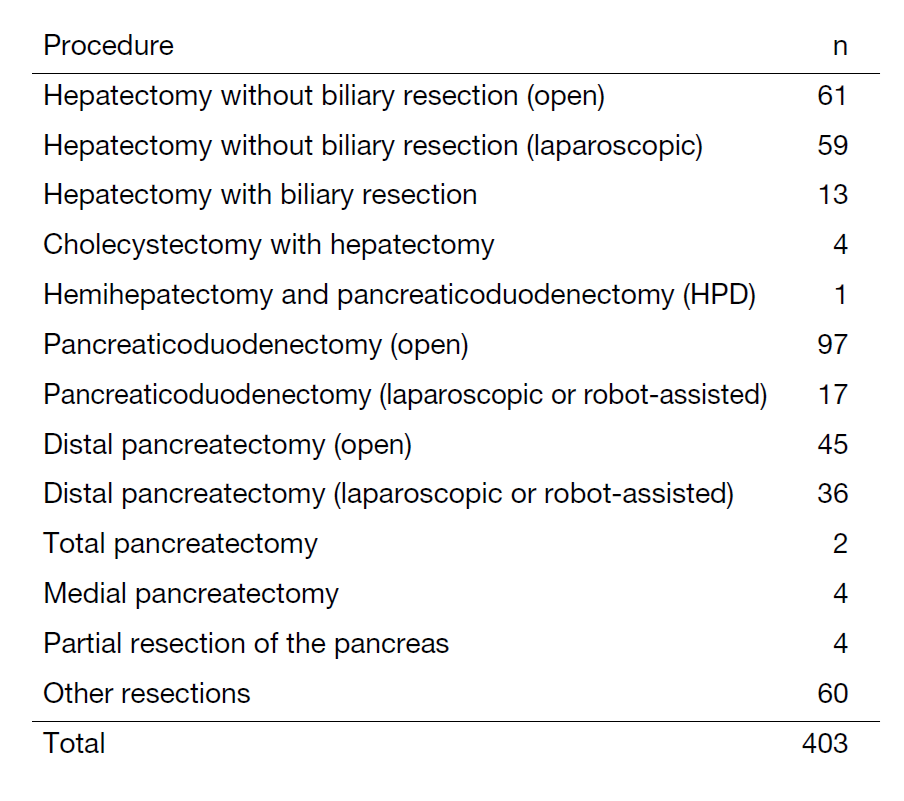Annual Report 2023
Department of Hepatobiliary and Pancreatic Surgery
Minoru Esaki, Satoshi Nara, Akinori Miyata, Takahiro Mizui, Ryosuke Umino
Introduction
The Department of Hepatobiliary and Pancreatic (HBP) Surgery manages malignant neoplasms arising from the liver, biliary tract including the gallbladder, and pancreas. We conduct aggressive surgical treatment and multidisciplinary treatment in cooperation with the Department of Diagnostic Radiology, the Department of HBP Oncology and the Department of Diagnostic Pathology.
The Team and What We Do
The Department of HBP Surgery consists of five staff surgeons. We perform more than 400 surgical procedures each year, with one chief resident and four or five residents. Occasionally, trainees from both Japan and overseas join our group.
Operation and perioperative care
One staff surgeon and one resident are in charge of each patient, perform the operation and provide perioperative care. The chief resident attends almost all the operations, supervises the residents and manages the care of all patients in the ward.
Conferences
Clinical and educational conferences on the diagnosis and treatment of HBP malignancies are held every morning. During the “Ward Conference”, the clinical conditions of the perioperative patients and the surgical strategies are discussed in detail for the preoperative patients twice a week. At the multidisciplinary team conference, so-called “Cherry Conference,” surgeons, endoscopists, oncologists, radiologists and medical sonographers discuss the imaging studies of the patients scheduled for HBP surgery. An “HBP Case Conference” is held by HBP surgeons, endoscopists and oncologists to discuss the treatment strategies, mainly for new patients. In a pathology conference, so-called “Micro-conference”, instructive postoperative cases are discussed, which is participated by surgeons, endoscopists, oncologists, radiologists, and pathologists.
Surgical strategies for HBP malignancies
Hepatocellular carcinoma (HCC): Surgical resection is usually indicated for patients with solitary or only a few tumors and with a favorable hepatic function. Resection is also indicated for large tumors or HCC with macroscopic vasculobiliary tumor thrombosis, provided that the patient has sufficient hepatic function and remnant liver volume. Alternative treatments to hepatectomy, including radiofrequency ablation, microwave ablation and trans-arterial chemoembolization, are always available in collaboration with medical oncologists and radiologists.
Pancreatic cancer: Multidisciplinary treatments with curative resection along with neoadjuvant and adjuvant chemotherapy constitute the standard strategy. Thanks to recent advances in systemic chemotherapy with improved response, the opportunities for conversion surgical resection for initially unresectable cancer due to locally advanced disease have been increasing.
Biliary tract cancer, such as ampullary cancer, cholangiocarcinoma and gallbladder cancer: Based on careful imaging evaluations of cancer extension, a wide variety of surgical resections can be applied to biliary cancer. Major resection including pancreatoduodenectomy and extended hemihepatectomy with extrahepatic bile duct resection, with or without vascular reconstruction, is frequently indicated. A safe and curative resection with careful perioperative management is essential.
Minimally invasive surgery: Laparoscopic hepatectomy is considered the first treatment choice for most liver tumors. Laparoscopic or robot-assisted pancreaticoduodenectomy, distal pancreatectomy and spleen-preserving distal pancreatectomy are also performed for patients with mainly low-grade malignant pancreatic tumors. Based on our experience with laparoscopic and robot-assisted surgery, we are extending the indication to pancreatic head ductal adenocarcinoma.
The number of diseases and surgical treatments are shown in Tables 1 and 2.
Table 1. Diagnosis for surgical treatment (between April 2023 and March 2024)

Table 2. Surgical procedures (between April 2023 and March 2024)

Research Activities
Our department plays a central role in conducting multi-institutional clinical trials in Japan. With the support of the Japan Agency for Medical Research and Development (AMED), Dr. Nara et al. are conducting JCOG1920 (a randomized phase III study of neoadjuvant chemotherapy with gemcitabine/cisplatin/S-1 versus upfront surgery for resectable biliary cancer).
In other JCOG trials, we continued the accrual of new patients for JCOG1315C (non-randomized controlled study comparing proton beam therapy and hepatectomy for resectable hepatocellular carcinoma), JCOG2101C (a randomized phase III study of preoperative therapy of gemcitabine/S-1 versus gemcitabine/nab-paclitaxel for resectable pancreatic cancer in geriatric patients), and JCOG2202 (a randomized phase III study of laparoscopic versus open distal pancreatectomy for pancreatic cancer).
We are also participating in many other multi-institutional clinical trials, including COSMOS-PC, COSMOS-HCC and COSMOS-BTC trials.
The results of two prospective clinical studies in cooperation with several domestic companies, aiming to develop surgical imaging tools using artificial intelligence that can assist liver resection (VAN-GOCH study, MARC-01 study) were recently published in international journals.
Each member of staff attends three to four domestic or international academic meetings per year. Residents and chief residents also have opportunities to make a presentation with the assistance of staff surgeons.
Education
Each resident attends major HBP surgeries once or twice a week, mainly as a first assistant. Depending on their skill, they also have the opportunity to act as the primary operator. For each case, they learn how to decide on the indication and the type of procedure based on the preoperative images. In the operating room, the residents learn not only each step of HBP surgery, but also tips on how to safely perform the surgery. Through two years of training, chief residents perform highly difficult HBP surgeries and aim to become board-certified expert surgeons (Japanese Society of Hepato-Biliary-Pancreatic Surgery) or endoscopic surgical skill qualified surgeons (Japan Society for Endoscopic Surgery). They may also conduct research for a year in the research institute. Motivated residents also have the opportunity to make presentations in academic meetings and write academic papers in English. Visitors from both domestic and foreign institutions are welcome anytime.
Future Prospects
HBP malignancy often requires technically demanding and invasive surgical procedures; however, its long-term prognosis is not yet satisfactory. Our most important mission is to establish safer and more feasible surgical techniques, including perioperative patient management, and to promote survival outcomes through multidisciplinary approaches. Owing to the recent advances in chemotherapy, we have achieved curative surgical resection for some of our patients with initially unresectable pancreatic cancer due to local advancement. We will therefore prospectively assess the feasibility of conversion therapy.
Minimally invasive surgical treatments with laparoscopic and robot-assisted surgery have been established for selected patients with low-malignant pancreatic tumors or primary/metastatic liver cancers that are not only peripherally located but also centrally located. We started to extend the indication of minimally invasive surgery for patients with more aggressive diseases and those undergoing repeat surgery.
We will continue to strive to create new skills and treatment strategies. We also expect to perform clinical trials to explore unclarified clinical questions.
List of papers published in 2023
Journal
1. Komiyama S, Okusaka T, Maruki Y, Ohba A, Nagashio Y, Kondo S, Hijioka S, Morizane C, Ueno H, Sukeda A, Mizui T, Takamoto T, Nara S, Ban D, Esaki M, Hiraoka N, Shimada K. Clinicopathological Findings and Treatment Outcomes of Patients with Primary Hepatobiliary Neuroendocrine Neoplasms: A Retrospective Single-institution Analysis. Internal medicine (Tokyo, Japan), 63:891-901, 2024
2. Doi N, Ino Y, Fuse M, Esaki M, Shimada K, Hiraoka N. Correlation of Vein-Rich Tumor Microenvironment of Intrahepatic Cholangiocarcinoma With Tertiary Lymphoid Structures and Patient Outcome. Modern pathology, 37:100401, 2024
3. Sakamoto S, Hiraide H, Minoda M, Iwakura N, Suzuki M, Ando J, Takahashi C, Takahashi I, Murai K, Kagami Y, Mizuno T, Koike T, Nara S, Morizane C, Hijioka S, Kashiro A, Honda K, Watanabe R, Urano Y, Komatsu T. Identification of activity-based biomarkers for early-stage pancreatic tumors in blood using single-molecule enzyme activity screening. Cell reports methods, 4:100688, 2024
4. Kashiro A, Kobayashi M, Oh T, Miyamoto M, Atsumi J, Nagashima K, Takeuchi K, Nara S, Hijioka S, Morizane C, Kikuchi S, Kato S, Kato K, Ochiai H, Obata D, Shizume Y, Konishi H, Nomura Y, Matsuyama K, Xie C, Wong C, Huang Y, Jung G, Srivastava S, Kutsumi H, Honda K. Clinical development of a blood biomarker using apolipoprotein-A2 isoforms for early detection of pancreatic cancer. Journal of gastroenterology, 59:263-278, 2024
5. Umino R, Nara S, Kobayashi N, Mizui T, Takamoto T, Ban D, Esaki M, Hiraoka N, Shimada K. Pathological complete response of initially unresectable multiple liver metastases achieved using combined peptide receptor radionuclide therapy and somatostatin analogs following pancreatic neuroendocrine tumor resection: a case report. Surgical case reports, 10:40, 2024
6. Saito R, Ban D, Mizui T, Takamoto T, Nara S, Esaki M, Shimada K. Oligo-like liver metastasis: A novel prognostic indicator to improve survival in pancreatic cancer. Annals of gastroenterological surgery, 8:481-489, 2024
7. Hirono S, Higuchi R, Honda G, Nara S, Esaki M, Gotohda N, Takami H, Unno M, Sugiura T, Ohtsuka M, Shimizu Y, Matsumoto I, Kin T, Isayama H, Hashimoto D, Seyama Y, Nagano H, Hakamada K, Hirano S, Nagakawa Y, Mizuno S, Takahashi H, Shibuya K, Sasanuma H, Aoki T, Kohara Y, Rikiyama T, Nakamura M, Endo I, Sakamoto Y, Horiguchi A, Hatori T, Akita H, Ueki T, Idichi T, Hanada K, Suzuki S, Okano K, Maehira H, Motoi F, Fujino Y, Tanno S, Yanagisawa A, Takeyama Y, Okazaki K, Satoi S, Yamaue H. Is multidisciplinary treatment effective for invasive intraductal papillary mucinous carcinoma? Annals of Gastroenterological Surgery, 2024
8. Sekiguchi M, Igarashi A, Toyoshima N, Takamaru H, Yamada M, Esaki M, Kobayashi N, Saito Y. Cost-effectiveness analysis of computer-aided detection systems for colonoscopy in Japan. Digestive endoscopy, 35:891-899, 2023
9. Takamoto T, Nara S, Ban D, Mizui T, Murase Y, Esaki M, Shimada K. Enhanced Recognition Confidence of Millimeter-Sized Intrahepatic Targets by Real-Time Virtual Sonography. Journal of ultrasound in medicine, 42:1789-1797, 2023
10. Ishimoto-Namiki U, Ino Y, Esaki M, Shimada K, Saruta M, Hiraoka N. Novel Insights Into Immunohistochemical Analysis For Acinar Cell Neoplasm of The Pancreas: Carboxypeptidase A2, Carboxypeptidase A1, and Glycoprotein 2. The American journal of surgical pathology, 47:525-534, 2023
11. Kawasaki Y, Hijioka S, Nagashio Y, Maruki Y, Ohba A, Takeshita K, Takasaki T, Agarie D, Hagiwara Y, Hara H, Okamoto K, Yamashige D, Kondo S, Morizane C, Ueno H, Mizui T, Takamoto T, Nara S, Ban D, Esaki M, Tamada K, Hiraoka N, Saito Y, Okusaka T. Efficacy of endoscopic ultrasound-guided tissue acquisition for solid pancreatic lesions 20 mm or less in diameter suspected as neuroendocrine tumors or requiring differentiation. Journal of gastroenterology, 58:693-703, 2023
12. Minagawa T, Itano O, Hasegawa S, Wada H, Abe Y, Kitago M, Katsura Y, Takeda Y, Adachi T, Eguchi S, Oshima G, Aiko S, Ome Y, Kobayashi T, Hashida K, Nara S, Esaki M, Watanabe J, Ohtani H, Endo Y, Shirobe T, Tokumitsu Y, Nagano H. Short- and long-term outcomes of laparoscopic radical gallbladder resection for gallbladder carcinoma: A multi-institutional retrospective study in Japan. Journal of hepato-biliary-pancreatic sciences, 30:1046-1054, 2023
13. Takamoto T, Nara S, Ban D, Mizui T, Murase Y, Esaki M, Shimada K, Hashimoto T, Makuuchi M. Objective Definition and Optimized Strategy for "Biologically Borderline Resectable" Colorectal Liver Metastases. World journal of surgery, 47:2834-2845, 2023
14. Nakachi K, Gotohda N, Hatano E, Nara S, Takahashi S, Kawamoto Y, Ueno M. Adjuvant and neoadjuvant chemotherapy for biliary tract cancer: a review of randomized controlled trials. Japanese journal of clinical oncology, 53:1019-1026, 2023
15. Nagashima D, Esaki M, Nara S, Ban D, Takamoto T, Mizui T, Shimada K, Hiraoka N. Novel insights into the intraepithelial spread of extrahepatic cholangiocarcinoma: clinicopathological study of 382 cases on extrahepatic cholangiocarcinoma. Frontiers in oncology, 13:1216097, 2023
